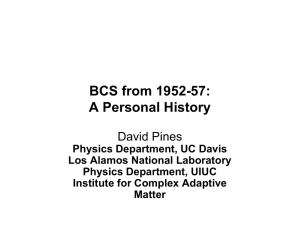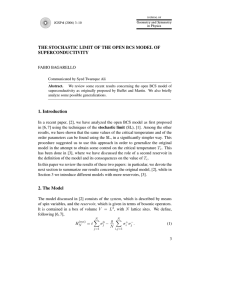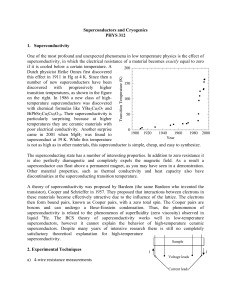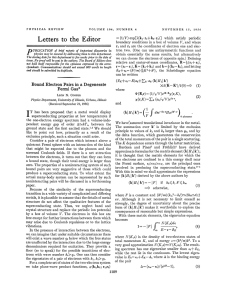The Emergence of BCS - University of Illinois Urbana
advertisement
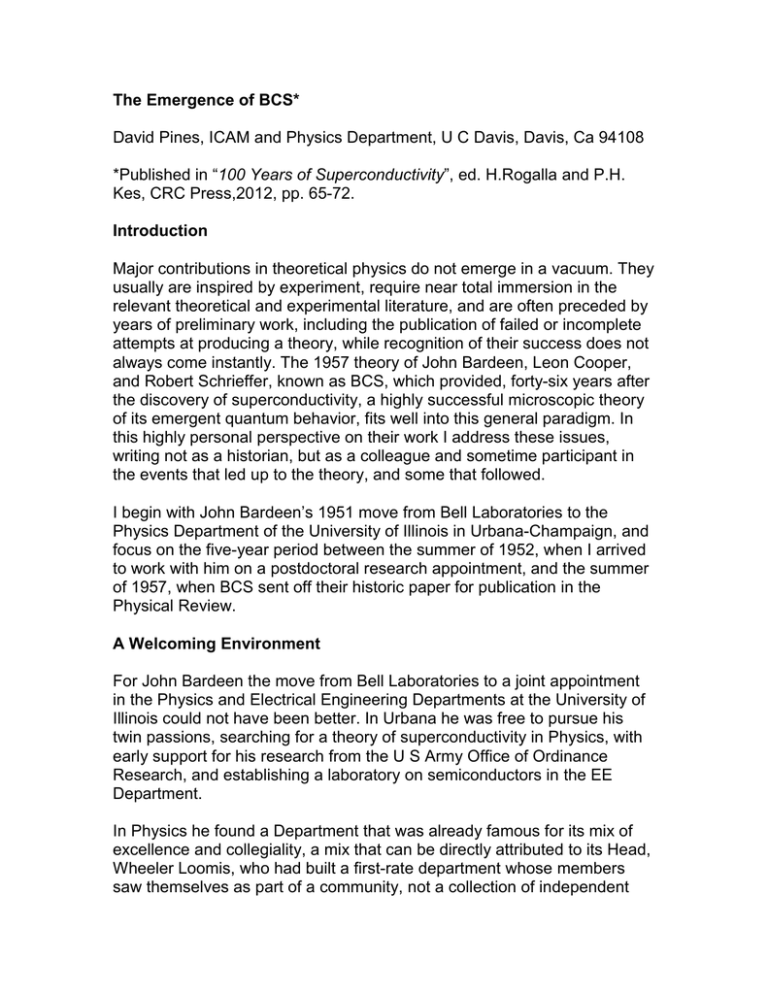
The Emergence of BCS* David Pines, ICAM and Physics Department, U C Davis, Davis, Ca 94108 *Published in “100 Years of Superconductivity”, ed. H.Rogalla and P.H. Kes, CRC Press,2012, pp. 65-72. Introduction Major contributions in theoretical physics do not emerge in a vacuum. They usually are inspired by experiment, require near total immersion in the relevant theoretical and experimental literature, and are often preceded by years of preliminary work, including the publication of failed or incomplete attempts at producing a theory, while recognition of their success does not always come instantly. The 1957 theory of John Bardeen, Leon Cooper, and Robert Schrieffer, known as BCS, which provided, forty-six years after the discovery of superconductivity, a highly successful microscopic theory of its emergent quantum behavior, fits well into this general paradigm. In this highly personal perspective on their work I address these issues, writing not as a historian, but as a colleague and sometime participant in the events that led up to the theory, and some that followed. I begin with John Bardeen’s 1951 move from Bell Laboratories to the Physics Department of the University of Illinois in Urbana-Champaign, and focus on the five-year period between the summer of 1952, when I arrived to work with him on a postdoctoral research appointment, and the summer of 1957, when BCS sent off their historic paper for publication in the Physical Review. A Welcoming Environment For John Bardeen the move from Bell Laboratories to a joint appointment in the Physics and Electrical Engineering Departments at the University of Illinois could not have been better. In Urbana he was free to pursue his twin passions, searching for a theory of superconductivity in Physics, with early support for his research from the U S Army Office of Ordinance Research, and establishing a laboratory on semiconductors in the EE Department. In Physics he found a Department that was already famous for its mix of excellence and collegiality, a mix that can be directly attributed to its Head, Wheeler Loomis, who had built a first-rate department whose members saw themselves as part of a community, not a collection of independent fiefdoms. Faculty in different sub-fields genuinely enjoyed one another’s company as they met regularly over lunch or dinner, attended one another’s seminars, and joined together in the weekly colloquia. New arrivals were welcomed, and even the most junior of these soon felt as much a part of the department as did the most senior professors. Bardeen’s friend from his Princeton days, Fred Seitz, was instrumental in attracting him to Urbana. On coming to Urbana two years earlier, Seitz had brought along three colleagues whose specialty was the then new sub-field of solid state physics, and with Bardeen’s arrival, Urbana’s leading role in the field [a position it continues to hold, as solid state has morphed into condensed matter] was firmly established. Starting work with Bardeen When I arrived in Urbana in early July,1952, as the department’s first research assistant professor (the position was invented to recognize my “advanced” postdoctoral status, since I had received my Ph.D. two years earlier) I was given a desk in the corner of Bardeen’s office. It was from this vantage point that I had the privilege and the pleasure of working with Bardeen for the next 2 ½ years, lunching with him almost daily, and being able to observe and absorb his approach to research on what was then the major challenge in theoretical physics, developing a microscopic understanding of superconductivity. Two years earlier, the experiments of Serin, Maxwell and their collaborators had provided an important clue to its physical origin. The dependence of the superconducting transition temperature on the mass of the ions in the lattice in which electrons moved showed that their coupling to phonons, quantized lattice vibrations, must play an essential role. However, the initial attempts by Bardeen and Frohlich to develop a theory based on the modification in the self energy of an electron brought about by that coupling had failed, and there appeared to be no unique path forward. Bardeen’s approach was to pursue, more or less simultaneously, a number of different possible avenues in the hope that one of these might pay off. Looking back, I can identify at least four of these: *learning from experiment--following closely the latest experimental results and trying to develop a phenomenological theory that tied these together, a process that culminated in his 1956 Handbook of Physics review article [1] *following and absorbing the latest theoretical developments in many-body physics and field theory, such as the multiple scattering theory for strong nuclear interactions being developed by Keith Brueckner and his collaborators, and the collective description of electron interactions I was working on with David Bohm * exploring matrix approaches to the problem of a few electrons excited above the Fermi surface * asking whether a strong-coupling approach to the coupled electronphonon problem might provide a further essential clue. As it turned out, each played a role in setting the stage for the microscopic theory he developed five years later with my successor as his postdoc, Leon Cooper, and his graduate student, Bob Schrieffer, five years later. I begin with the last of these four approaches, because that was the raison-d’etre for the problem Bardeen suggested I study on my arrival— developing a theory of polarons, single electrons moving in polar crystals that are strongly coupled to the optical lattice vibrations found there. Polaron Theory Bardeen suggested that I familiarize myself with earlier work on polarons by reading the seminal papers of Solomon Pekar and Herbert Frohlich, who had studied the limit in which polarons were weakly coupled to lattice vibrations, and Lev Landau, who had shown that a polaron could become self-trapped by very strong coupling to lattice vibrations. Not long after I started work on the problem, I encountered Tsung-Dao [T.D.] Lee in the hallway, and we started exchanging information on our summer research plans. Lee was spending that summer in Urbana, before moving to Columbia University, and we had met earlier in Princeton. Within minutes we realized that we could connect his planned work on the coupling of pions to nucleons, using a method developed by Sin-itro Tomanaga, to my fledgling effort on polaron theory, and we soon were able to send off a letter to Physical Review reporting on our intermediate coupling theory of the polaron self-energy. When, a few weeks later, I described the progress T.D. and I had made on polarons to another close friend in the Physics Department, Francis Low, a quantum field theorist who had also arrived in the Physics Department that summer, he proposed what became known as the LLP wave function [2] as a much simpler way to express our results. In it, one sees clearly that the virtual phonons in the cloud of excitations moving with the polaron are emitted successively into the same momentum state: ΨLLP ~ exp [Σk[f(k)[ ak*+a-k] Ψ0 where Ψ0 was the ground state wavefunction, the operators ak* and ak act to create or destroy phonons, and f(k) describes the phonon state. [In the language of Feynman diagrams, this corresponds to summing all the “rainbow” diagrams, in which each new virtual phonon is emitted successively into the same quantum state.] Our work represented the first non-trivial extrapolation of approaches developed in particle physics to a problem in solid-state physics. Looking back, there were perhaps three reasons it came about. First, I was part of an emerging generation of theorists who grew up acquainted with the newly developing methods in quantum field theory due to Feynman, Schwinger, and Tomonaga. Second, T.D. was in Urbana that summer because Wheeler Loomis had realized that summer appointments made it possible to attract great young theorists to Urbana [C.N. (Frank)Yang was his immediate predecessor in that visiting position]. Third, the world of theoretical physics was still quite small, so T.D., Francis, and I frequently talked to colleagues in different sub-fields about our current research. It is perhaps worth noting that the summers of 1952 and 1953 in Urbana were not only remarkable for their record setting heat records but also for the concentration of young theorists there, as T.D. came back for a second summer to work with John Bardeen on superconductivity and me on polarons, while the three of us were joined by Murray Gell-Mann who came down from Chicago to work with Francis, and briefly with me. Effective Electron Interactions in Metals After working on polarons, I returned to working, at a distance, with my thesis supervisor, David Bohm, on writing up the results of my 1950 Ph.D thesis for publication [3], and soon found myself trying, with limited success, to generalize our collective description of electron interaction to the more general problem of electrons coupled to each other and to phonons. Within the random phase approximation [RPA] which Bohm and I had used to treat electron-electron interaction, I could obtain the modification in the phonon dispersion relation brought about by their coupling to electrons, but was unsuccessful in arriving at a self-consistent treatment of the net effective electron interaction, and so was not in a position to answer the key question: how does the strong repulsive Coulomb interaction between electrons modify the electron-phonon interaction that gives rise to the apparently weak attractive phonon-induced interaction between electrons that Frohlich [4] had conjectured in 1952 might be the way phonons make possible a transition to the superconducting state, and what is the net interaction that results when this Coulomb repulsion is included? As I was describing my lack of progress to Bardeen one morning in late 1953, he suggested that I consider adding an explicit phonon contribution to the canonical transformation I was using to go from my introduction of an arbitrary supplementary field to describe collective motion to coordinates that could describe the collective modes of the coupled electron-electron-phonon system. I tried putting that in, and everything worked. We then joined forces and were soon able to obtain a selfconsistent account, within the RPA, of the way electron interactions modified their coupling to ions and to one another and how the combined ionic and electronic Coulomb interactions gave rise to two collective modes, sound waves and plasma oscillations, and a net effective electron interaction [5]. The resulting phonon dispersion relation turned out to be just that Bardeen had calculated seventeen years earlier in his seminal 1937 paper on lattice vibrations in simple metals [6], while the effective electron-electron interaction turned out to have properties that were similar to those Frohlich had found, but with full account now having been taken of all the interactions in play. We found that for pairs of electrons whose energies differed from each other by less than a typical phonon energy, the attractive interaction brought about by phonon exchange could win out over the repulsion coming from the now present and properly screened Coulomb interaction. For these electrons, the net effective electron-electron interaction would be attractive; for larger energy differences, the repulsive screened Coulomb interaction would win out and their net interaction would be repulsive. Since a full account of the Coulomb interaction had now been taken into account, we closed our paper with the prophetic line, “The equations we have presented here should provide a good basis for development of an adequate theory.” As Nozieres [7] subsequently pointed out, our results for the net effective frequency–dependent electron interaction at low frequencies, Veff, could be put in an especially simple form if one neglected the periodicity of the ionic lattice, the so-called “jellium” model for a metal: Veff (q,ω) = [4πe2/q2 ε(q,0)] [1 + ω q2 /(ω2-ωq2) ] where ε(q,0) is the static dielectric constant, and the second term, proportional to the square of the frequency of the phonon being exchanged, is the phonon-induced contribution to the net effective interaction. The screened Coulomb interaction sets the overall scale for the strength of the interaction, and it is evident that the net interaction will always be attractive for those electrons of momentum p and p+q near the Fermi surface whose energy difference, ω = εp+q -ε p , is below the natural resonance frequency, ωq, of the phonon that is being virtually exchanged. Cooper’s Pair Instability When I left Urbana for Princeton in January, 1955, Bardeen sought a successor who was familiar with quantum field theory. He asked the advice of Frank Yang at the Institute for Advanced Study, which by then had a large postdoctoral program, and Frank recommended Leon Cooper. As Cooper tells the story [8] when he arrived in Urbana that fall, he knew nothing of superconductivity, so his first months were devoted to a crash course in its fundamentals—reading David Shoenberg’s excellent monograph, and absorbing Bardeen’s work-in-progress on his Handbook review on superconductivity. John encouraged him to look at the behavior of a few electrons excited above the Fermi surface, and within a year he made a key discovery as he studied the behavior of two electrons of opposite spin and momentum whose interaction would be attractive if they were close to the Fermi surface --a simplified version of the Bardeen-Pines attractive interaction. In a calculation [9] that allowed for the multiple scattering of the pair above the Fermi surface, he showed that such an attraction could give rise to a bound state. If his approach could be extended to an actual many-electron problem, it would correspond to the energy gap in the elementary excitation spectrum of superconductors that Bardeen had shown could provide a phenomenological explanation for the recent experiments on the specific heat and the penetration of magnetic fields into superconductors. Cooper’s work served to confirm the role for phonons in superconductivity that Frohlich had conjectured, and that Bardeen and I had demonstrated could occur even in the presence of strong Coulomb repulsion -- that a net attractive interaction produced by the phonon-induced electron interaction was the gateway for superconductivity. But it did not provide a path forward to explaining how that attraction gave rise to the signature hallmark of superconductivity—the emergence of a single quantum state to describe superfluid flow, whose rigidity London had eloquently argued could explain perfect diamagnetism. Seattle and Stockholm During the following year, superconductivity was front and center at a number of international conferences. At the September, 1956 international conference on theoretical physics held in Seattle, John Blatt outlined the approach he, Butler and Schafroth were making to superconductivity, in which they assumed that it resulted from the Bose-Einstein condensation of pre-formed pairs of electrons. Because there was no experimental evidence for such pre-formed pairs, their proposal was received with some skepticism by those present. At that same meeting, Richard Feynman, in the course of a lecture on his seminal work on liquid helium, made it clear that he had turned his attention to superconductors, but had no theory to present as yet. Bob Schrieffer, by then in his third year of graduate work with John Bardeen in Urbana, with a planned thesis on superconductivity, was one of the principal note-takers on the Seattle lectures. He returned home worrying that not only had he yet to make significant progress, but that in Feynman he and Bardeen had a formidable competitor. I can testify firsthand to Feynman’s immersion in the problem. During a two-week visit I made to Caltech in December, 1956, almost every day over lunch he would try out another idea on me. For example, he proposed that since so few superconductors were monovalent, it must be the combination of multivalent lattice structure and vibrations that made the latter superconduct, and suggested an approach that I told him was pretty much identical to the one that Bardeen had first tried, unsuccessfully, to work through in 1937. Additional competition for Schrieffer and Bardeen had emerged earlier that fall, when Bardeen received word that he had been awarded the 1956 Nobel prize for his discovery of the transistor. This meant he had to set aside his current work on superconductivity to prepare his Nobel lecture and go to Stockholm in December,1956, to receive the prize. What made Bardeen so different from most Nobel laureates was that instead of basking in the Nobel-induced limelight, he could scarcely wait to get home to resume his research. The Schrieffer Wave-Function The following month [January. 1957], an International Conference on the Many-Body Problem was held at the Stevens Institute in Hoboken. Bob Schrieffer was among the attendees. As he describes in detail in his 1964 book, “The Theory of Superconductivity” [10], he had been working with Bardeen to find a variational wavefunction that might describe the ground and excited states of a superconductor. While riding an NYC subway train following the Hoboken meeting, he had his “Aha moment”. He realized that he could generate a candidate wave function by assuming that the key physics was the formation of a macroscopically occupied coherent quantum state made up of pairs of electrons (of opposite spin and momentum) and then adapting the Lee-Low-Pines intermediate-coupling ground-state wave function to describe it. In his variational approach, the LLP phonon field was replaced by the coherent pair field of the condensate, bk*=ck↑*c-k↓*, where c and c* are the annihilation and creation operators for a single quasiparticle. When Schrieffer applied it to the model Hamiltonan used by Cooper, he was able to calculate the reduction in the ground state energy brought about by his hypothesized pairing condensate, and obtain an energy gap for excitations from that new ground state. Schrieffer’s proposed gateway to emergent superconducting behavior was a quite remarkable coherent state of matter; the pairs in the condensate need not be physically located close to one another, while their condensation is not the Bose condensation of pairs that pre-form above the superconducting transition temperature in the normal state. Instead the pairs condense only below the superconducting transition temperature, and the typical distance between them can be some hundreds of times larger than the typical spacing between particles. On Schrieffer’s return to Urbana, he showed his results to Cooper and then to Bardeen. Bardeen quickly recognized that this was the correct basis for finding a solution to superconductivity, and with great excitement, he, Schrieffer, and Cooper began to work out its consequences for the ground and excited states of a superconductor. Within some two weeks, they had developed the microscopic theory that soon became known as BCS, and on February 18, 1957 sent a brief account of their results for publication in Physical Review Letters [11]. Deciphering, teaching, and applying BCS In early 1955 I left Urbana for Princeton, and it was there, some two years later, that I received a brief letter from John reporting that he thought superconductivity had been solved, and enclosing a dittoed copy of their not-yet-published PRL. I shared the news with Elihu Abrahams, who was newly arrived at Rutgers, and my prize graduate student, Philippe Nozieres. Filled with excitement, we decided to see if we could flesh out the details of what BCS had done. Since the details provided in their manuscript were scant, doing so proved to be non-trivial, but after three intensive days in our living room on Clover Lane we succeeded sufficiently well that I was able to teach it to my class later that spring. In the course of these lectures I did some simple calculations showing how the effective interaction that John and I had derived, and that formed the starting point for BCS, led in a natural way to the famous empirical rules for the occurrence of superconductivity that had been proposed by Bernd Matthias [12]. I showed these to John when he came to Princeton to give what may have been his first colloquium on BCS; he encouraged me to publish these as what turned out to be a first application of their theoryshowing that the requirement that the net interaction be attractive enabled one to distinguish between metals that would superconduct, and those that would not. What I did in this paper [13] was first to see how well one could do with a “minimalist” approach to calculating the average effective interaction V, which had to be attractive to bring about superconductivity, and the product N(0)V that determined the superconducting transition temperature, Tc, in the then-fledgling BCS theory. I took the repulsive part to be a screened Coulomb interaction and considered separately the contributions to the attractive part coming from normal processes (in which the interacting electron momentum differences were less than a typical phonon wave vector, kD and the Umklapprocesses (U processes) in which their momentum difference was q+Q > kD, where Q is a reciprocal lattice vector. For the latter, I further assumed that the momentum of the phonon being exchanged was always kD, which underestimated the contribution of U processes to V. I was thus able to obtain a simple analytic expression for N(0)V that depended only on the effective ion charge, Z*, and rs, the dimensionless interelectron spacing. Within this simple model, the net attraction coming from N processes alone was not strong enough to overcome the screened Coulomb repulsion, so that, for example, jellium would never superconduct. When U processes were included, the model turned out to do quite well at distinguishing between normal and superconducting elements in the periodic table and even had predictive power, in that it predicted the superconductivity of Mo, W, Y, Sc, and Pa, and, with minor modification, could explain the empirical rules developed by Matthias. BCS Theory As soon as their manuscript describing their initial results was sent off for publication, Bardeen, Cooper, and Schrieffer set about developing the theory in detail; less than five months later, they were able to send the long paper describing their theory to the Physical Review, which received it on July 8, 1957 [14]. Their results included the microscopic description of the two fluids that characterize superconducting behavior: the superfluid, a single macroscopic quantum state, formed by the condensation of pairs whose average spacing is large compared to the inter-electron spacing, that flows without resistance and acts to screen out external magnetic fields; and a normal fluid that is made up of the “pair-breaking” elementary excitations that a finite amount of energy—the energy gap—is required to excite. These quasiparticles scatter against each other and impurities much as normal electrons do. In using Schrieffer’s wave function to calculate various properties of the superconducting state, Bardeen, Cooper and Schrieffer were guided at every stage by the phenomenological description Bardeen had enunciated two years earlier, with what quickly became recognized as remarkable success. Remarkably, their new theory was also able to explain the quite surprising results of a measurement that had just been completed in Urbana by Charlie Slichter and his student, Chuck Hebel, on the change in the nuclear spin-lattice relaxation rate when a material becomes superconducting. So how was it that Bardeen and his young collaborators were able to solve the riddle of superconductivity? The solution had, after all, eluded their many distinguished theoretical colleagues who were working on the problem at that time – notably Feynman, Landau, Frohlich, Ginzburg, Blatt and Schafroth. The answer is, in part, to be found in Bardeen’s emphasis on understanding the experimental facts and developing a phenomenological description of these while simultaneously pursuing a number of different theoretical scenarios with his younger colleagues. Equally important was his total dedication to cracking the problem, and the encouragement, support and freedom to pursue their own ideas that he gave to his younger colleagues, who played such key roles in the development of the theory. The story of BCS is now a highpoint in the history of physics in the twentieth century. The theory, for which its authors received the 1972 Nobel Prize in Physics, not only explained all existing experiments on superconductors, but made a number of predictions that were subsequently verified, It quickly had an impact on other fields of physics. In the summer of 1957 the key BCS idea –that a net attractive interaction between fermions (particles of intrinsic spin ½) would always lead to a pairing state that was macroscopically occupied—was applied to atomic nuclei by Aage Bohr, Ben Mottelson and the author [15], and soon thereafter was taken into the realm of particle theory by Yoichiro Nambu and. and Gianni Jona-Lasinio [16]. Indeed, within two years it had become so clear that the BCS theory was successful that David Shoenberg, in his introductory remarks at a 1959 superconductivity conference at Cambridge, was led to make his classic remark "Let us see to what extent experiment can explain the theoretical facts." Acknowlegments In preparing this perspective I have drawn upon my memoir of John Bardeen prepared for the American Philosophical Society [17], on a chapter I wrote for the on-line text, Physics for the Twenty-first Century [18], and on a talk given as part of the UIUC celebration of the 50th anniversary of BCS [19], a written version of which will soon appear [20], so the reader should not be surprised by any similarities in wording that may have resulted from this process. References 1. J. Bardeen, Encyclopedia of Physics [Springer-Verlag, Berlin ,1956], Vol 15, p 274. 2. T. D. Lee. F.E. Low, and D. Pines, Phys.Rev. 90, 297, 1955 3. D. Bohm and D. Pines, Phys.Rev. 92, 609, 1953; D. Pines, Phys.Rev 92, 626, 1953) 4. H. Frohlich, Proc.Royal Soc. [London] A215, 291 [1952] 5. J. Bardeen and D. Pines, Phys. Rev.99,1140 [1955] 6. J. Bardeen, Phys.Rev. 52, 688 (1937). 7. P. Nozieres, 1957 private communication to the author 8. L.N. Cooper, in Bardeen, Cooper, and Schrieffer 50 Years , World Scientific Pub., in the press, 2010 9. L.N. Cooper, Phys.Rev.104, 1189 [1956] 10. J.R.Schrieffer, The Theory of Superconductivity, W.A. Benjamin,New York, 1964. 11. J. Bardeen, L.N. Cooper, and J. R. Schrieffer, Phys.Rev.106,162 [1957] 12. B. Matthias, in Progress in Low Temperature Physics [North-Holland, Amsterdam,1957],vol. 2 13. D. Pines, Phys.Rev. 109, 280,1958 14. J. Bardeen, L.Cooper, and J.R. Schrieffer,Phys. Rev. 108, 1175 [1957] 15. D. Pines in Proc.of the Rehovoth Conf.on Nuclear Structure, Interscience Press,1957), p 26 ; A.Bohr, B. Mottelson, and D. Pines, 110, 936,1958 16. Y. Nambu and G. Jona-Lasinio, Physical Review 122, 345 [1961]; ibid 124, 246 [1961] 17. D. Pines, Proc. American Philosophical Society 153, 288 [2009] 18. D. Pines, in Physics for the 21st Century, http://www.learner.org/courses/physics/unit/text.html?unit=8&secNum=0 [2010]. 19. http://www.conferences.uiuc.edu/bcs50/video.html 20. D. Pines, in Bardeen, Cooper, and Schrieffer 50 Years , World Scientific Pub., in the press, 2010
